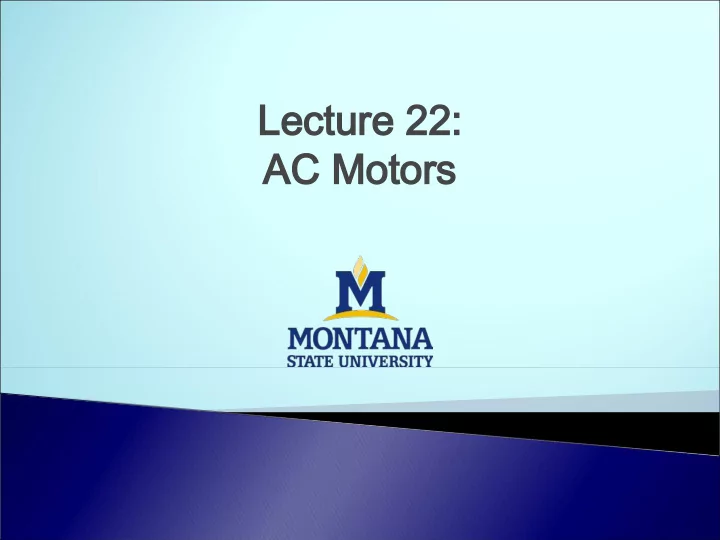

Lectur Lecture 22: e 22: AC M AC Motor otors
AC M AC Motor otors • Two main types of AC Motors – Induction (non-synchronous) Motors • Workhorse of industry – rugged, reliable, cheap • Only stator externally excited • Rotor spins at frequency less than excitation – Synchronous Motors • Requires stator and rotor to be externally excited • Can provide power factor correction • Rotor spins at frequency equal to excitation • Other important types of AC Motors – Universal Motors – Operate on DC or AC supply • Widely used in home appliances and power tools
Recall: DC M Recall: DC Motor otor Oper Operation ation • Simplest DC Motor – single loop coil With Commutation
Motor otor Com Commutation utation
Thr Three- ee-Phase Induction M Phase Induction Motor otors • Construction - Stator – Windings typically embedded in slots to produce electromagnets. Rotor goes in here Both diagrams 2-pole 3-phase stators
Thr Three- ee-Phase Induction M Phase Induction Motor otors • Construction - Rotor – Two general types of Rotor Construction Squirrel-Cage Rotor Wound Rotor
Thr Three- ee-Phase Induction M Phase Induction Motor otors • Operating Principle – Three-phase source connected to motor windings – Produces rotating magnetic field in the stator – This var varying ying magnetic field induces voltage on rotor bars (squirrel cage) or windings (wound) • Same as operation of transformer secondary – Voltage causes current to flow in rotor conductors – Force on conductors due to current flow in changing magnetic field – Rotor turns due to torque (force x distance) – NOTE: Speed of rotor less than that of rotating magnetic field
Thr Three- ee-Phase Induction M Phase Induction Motor otors • Operation: Generating rotating magnetic field of stator Consider Resulting Magnetic Field every 30º
Thr Three- ee-Phase Induction M Phase Induction Motor otors • Time instance 1:
Thr Three- ee-Phase Induction M Phase Induction Motor otors • Time instance 1: Equivalent Magnetic Field
Thr Three- ee-Phase Induction M Phase Induction Motor otors • Time instance 2:
Thr Three- ee-Phase Induction M Phase Induction Motor otors • Time instance 2: Equivalent Magnetic Field
Thr Three- ee-Phase Induction M Phase Induction Motor otors • Time instance 3:
Thr Three- ee-Phase Induction M Phase Induction Motor otors • Time instance 3: Equivalent Magnetic Field
Thr Three- ee-Phase Induction M Phase Induction Motor otors • Time instance 3:
Thr Three- ee-Phase Induction M Phase Induction Motor otors • Time instance 3: Equivalent Magnetic Field
Full Cycle of Rotating Field Full Cycle of Rotating Field
Speed of Rotating Field Speed of Rotating Field • Previous discussion on 2-pole 3-phase motor – 1 electrical cycle corresponds to 1 magnetic field cycle • 60 Hz (3600 RPM) • More poles reduces speeds – 4-pole → 30 Hz (1800 RPM) – 6-pole → 20 Hz (1200 RPM) – etc.
Speed of Rotor Speed of Rotor • Rotor speed LESS LESS than synchronous speed – Percent difference called slip • Rotor “slips” because otherwise: – No changing (relative to rotor) magnetic field – No currents induced in rotor – No force on rotor – Thus, rotor only spins because there is slip. • Typical slip between 1 and 5% of synch speed – Depends on load.
Standar Standard Squir d Squirrel Cage el Cage Motor otor Char Character acteristics istics • Torque and speed as functions of slip
Standar Standard Squir d Squirrel Cage el Cage Motor otor Char Character acteristics istics • Speed, Efficiency, PF, Current and Torque as functions of Load
Quick Question Quick Question • How can you easily change the rotational direction of an induction motor?
Quick Question Quick Question • How can you easily change the rotational direction of an induction motor? • ANSWER: Interchange two of the electrical phase- leads.
Other Other Types of Induction Types of Induction Motor otors • Double squirrel-cage rotor – Has two squirrel-cage windings – Inner winding has low resistance and high inductance • High Impedance (due to reactance) at startup • Low impedance at rated speed – Outer winding has high resistance and low inductance • Low impedance startup • High impedance (due to resistance) rated speed – High starting torque due to outer winding!
Other Other Types of Induction Types of Induction Motor otors • Wound-Rotor Induction Motor – Windings connected to slip-rings (similar to brushes of DC motor – Slip-rings connected to external variable resistors • Resistors used to optimize current – High starting torque – Control speed when under constant load – Smooth acceleration – Disadvantages • Higher costs • More maintanence
Last bit of class Last bit of class • Project – due Monday 12/2 • Optional HW 7 – Will be put on D2L by Wednesday • Last week of class – Monday 12/2 - Continue AC Motor Discussion – Wednesday 12/4 – In class review • Final 12/12 – Location TBA (but probably this classroom)
Recommend
More recommend